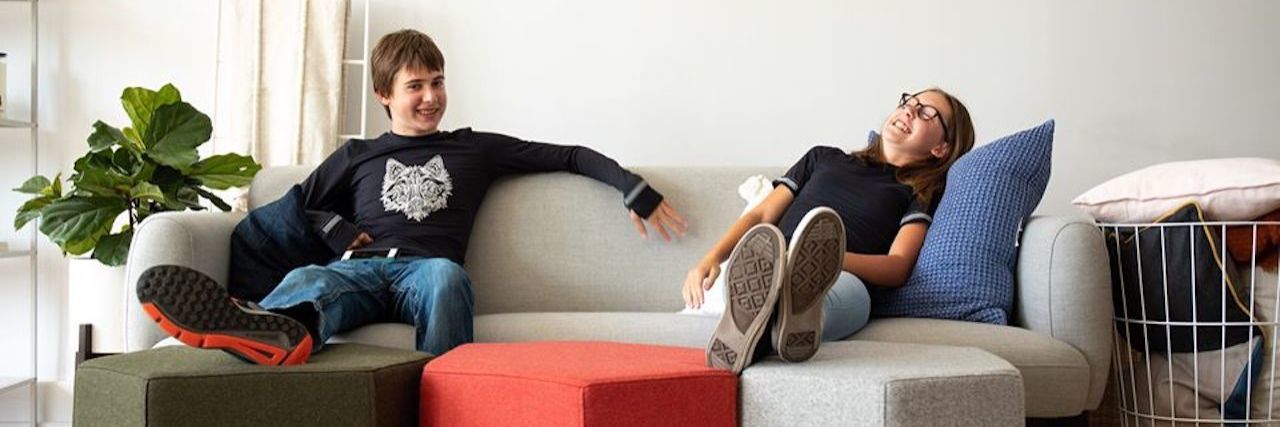Major retailers, like Tommy Hilfiger, Kohl’s and Zappos, have expanded their products into the adaptive fashion world with softer fabrics, no tags, zippers and velcro for easy access and different sizing. However, all of these brands expanded after they were already successful. One fashion designer did it differently and started her line with real people in the autism community to create a fashionable and functional compression shirt.
Designer Molly Fuller had her eye on fashion design for people with medical needs and disabilities early on. Her grandfather has polio, and she noticed how clothing doesn’t fit him comfortably when he uses his wheelchair. While in school, Fuller collaborated on projects to redesign diabetic shoes and other compression garments. It was working with an occupational therapist, however, that became the seed for her company, Molly Fuller Designs, and her first product, the Charlie shirt.
“The kids were being bullied [because] the clothing didn’t really look right but they but they needed to wear weighted jackets or have that compression to help them reduce anxiety and stay calm,” Fuller told The Mighty. She added:
I started first with doing a survey that I actually posted on Facebook and emailed out and had people share it around and got feedback from occupational therapists, teachers, parents and autistic people around where they liked compression, if they like it at all, different sensory questions around what they like, what they didn’t like.
Fuller took feedback from her survey and discovered most autistic people preferred compression around their torso. She designed three initial shirts, which she sent off to a kid on the spectrum in Ohio as her pilot tester. Once she modified the compression shirt based on his feedback, she sent out another 10 shirts to additional autistic kids to get more insight.
What Fuller landed on is a shirt, available in both short and long-sleeve styles, comprised of 12% Spandex, compared to other shirts like Under Armour, which are only 5% Spandex, according to Fuller. The Charlie shirt is longer in the hips so kids can pull the shirt down or bunch it up and still have the same amount of compression. The fabric is soft and tagless to account for other sensory sensitivities, and it has a built-in fidget feature.
Fuller’s designs focused on autistic people first because she heard a need for more fashionable compression options to help autistic kids regulate their sensory experiences while feeling good in their clothing. Autism advocate and Mighty contributor Kerry Magro called for more such clothing design in his article, “Why I’m Asking More Businesses to Offer Sensory-Friendly Clothing Options.” Magro wrote:
That negative connection I’d have for certain clothes would continue for many years during my adolescence. As part of my early intervention plan, my parents started getting me used to different sensory activities that I’d do with my occupational therapists. I had a sensory brush that I’d use for a few minutes each day, starting by using it on my hands, then on my arms, legs and shoulders. This helped tremendously towards my sensory development.
The Charlie shirt and its carefully designed features for kids with sensory processing issues also highlights that more companies should start considering the diverse needs of people with disabilities and neurodiverse experiences from the beginning. Universal design — products that accommodate the needs of everyone — shouldn’t be groundbreaking or out of the ordinary.
“We shouldn’t be praising designers for featuring accessible clothing options or models with disabilities. We should be asking why more don’t,” wrote Jordan Davidson, The Mighty’s managing editor. “Despite more brands embracing adaptive fashion, it’s still considered revolutionary when companies feature adaptive designs or inclusive advertising. It shouldn’t be.”
Another concern with adaptive fashion is the price. Families of kids with disabilities or adaptive needs often spend thousands extra every year, Fuller said, to provide the same basics typical kids get more affordably. When Fuller priced her compression shirts, she had this in mind to find a balance point.
“My goal is to kind of decrease prices as much as possible, but also still deliver on something that was going to be a high-quality,” Fuller said. “I work with a seamstress who’s locally in St. Paul, just the city over for me, and so I know that she’s getting paid a fair wage, I know that she’s delivering on really great quality. Those things are really important to me as well.”
Both the long-sleeve and short-sleeve Charlie shirt cost $50 each, and a $60 version of the long-sleeve shirt has a wolf design on the front. It’s currently available for kids sizes extra-small through extra-large. The shirts also fit adults who wear size medium (the extra-large kid’s size) or smaller. Fuller plans to expand her sizing for younger children ages 3 to 10 and eventually expand to additional larger sizes and other clothing designs, like blazers.
If you have a child on the spectrum, Fuller needs testers as she expands her products to ensure autistic people are included at every stage of the design.
“I’m trying to work to find kids who are between the ages of 3 and 10,” Fuller said. “I’m always open to feedback in trying to form this thing on the website called the ambassador group for parents or for people with autism who want to be a part of testing or providing feedback to something that I’m trying to curate. So I want to make sure that I’m designing with people, not just for them.”
To learn more about the Charlie Shirt or become an ambassador for Molly Fuller Design, check out the website.
Header image via Molly Fuller Design’s Facebook

